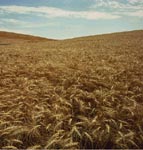|
|
|
 |
| 1970-1979 |
 |
Celebrating Over 90 Years of scientific excellence in agricultural sciences and human nutrition
|

|
Disease resistant germplasm of corn, wheat, sugar beet, alfalfa, and barley is released which contributes to the `green revolution'.
Research contributes many improvements in artificial insemination from a procedure for manually stimulating ejaculation in turkey roosters and toms to the Beltsville TS semen extender.
|

|

|
This technology to freeze and thaw chicken sperm is adapted for breeding endangered avian species such as cranes and raptors in captivity.
|

|

|
Viroids, the smallest known agents of plant disease, are discovered.
Land transferred to the Secret Service.
|

|

|
It is demonstrated that supplementing vitamin A with zinc helps prevent blindness in humans; and the importance of dietary chromium and it's relationship to blood sugar management is determined.
Procedures are developed that are used around the world to control mastitis, a dairy disease that cost U.S. dairy producers $2 billion dollars annually. Control of this disease, allows milk to be bacteria and antibiotic free.
|

|

|
Research leads to the eradication of Venezuelan equine encephalomyelitis in 1971, sheep scabies in 1973, Newcastle disease in 1974, and hog cholera in 1978.
|

|

|
Impatiens species are collected in New Guinea and hybrid germplasm is created. This germplasm is used to develop the first New Guinea impatiens cultivars.
|

|


|
Beltsville Aerated Pile Method for composting sewage sludge, currently called biosolids, is developed. Today, the method is used by more than 160 municipalities.
|
|
|
|
|
|
|
Last Modified: 03/03/2008
|
|
|